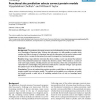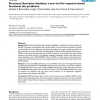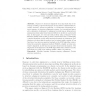23 search results - page 2 / 5 » Residue Contexts: Non-sequential Protein Structure Alignment... |
BMCBI
2008
13 years 5 months ago
2008
Background: The prediction of protein structure can be facilitated by the use of constraints based on a knowledge of functional sites. Without this information it is still possibl...
BMCBI
2004
13 years 4 months ago
2004
Background: The wealth of information on protein structure has led to a variety of statistical analyses of the role played by individual amino acid types in the protein fold. In p...
BMCBI
2008
13 years 5 months ago
2008
Background: The Structural Descriptor Database (SDDB) is a web-based tool that predicts the function of proteins and functional site positions based on the structural properties o...
RECOMB
2007
Springer
14 years 5 months ago
2007
Springer
Abstract. Sequence to structure alignment is an important step in homology modeling of protein structures. Incorporation of features like secondary structure, solvent accessibility...
BMCBI
2005
13 years 4 months ago
2005
Background: Protein sequence alignments have become indispensable for virtually any evolutionary, structural or functional study involving proteins. Modern sequence search and com...



